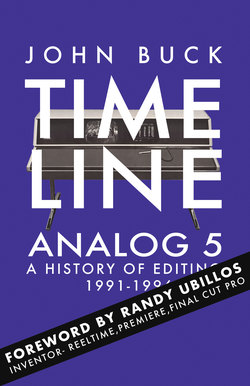Читать книгу Timeline Analog 5 - John Buck - Страница 10
На сайте Литреса книга снята с продажи.
THE AUGUST COUP
ОглавлениеIn August 1991 members of the Soviet Union's government tried to take control of the country from Soviet President and General Secretary Mikhail Gorbachev in the August Coup.
Days later Boston's Bayside Expo was home to the seventh Macworld, the twice-annual Macintosh trade show.
The Bayside Expo Center was a convention center located in Dorchester, Massachusetts that started life as a shopping mall in the 1960s. When the mall eventually failed it was converted into a convention center.
With QuickTime set to ship at the end of 1991, Macintosh users were keen to see what third parties could do with the new Apple extension. RasterOps, Gold Disk, Digital F/X, DiVA, and Letraset dueled for the attention of desktop video makers.
John Pavley and Richard Trismen from Letraset were set up in Apple’s QuickTime preview room with a "technology demonstration" of Media Blender. Their video editing program visualized the contents of a QuickTime file as a set of horizontal bar graphs. Pavley recalls:
Many other development teams had come up with the same idea and a standard convention was born.
MediaBlender was aimed at users who wanted an uncomplicated way to edit video. Pavley told the press:
We want to have the easiest and least expensive video program. Nobody knew anything about desktop publishing when it first came out, but now you have secretaries who know about kerning. In a couple of years, they'll know all about scene transitions.
Using loan Mac equipment in a booth funded by Apple, the team from DiVA demonstrated their VideoShop application that allowed users to digitize video, then view and arrange the clips or edit graphics and audio files. Luyen Chou from the Lab for Teaching and Learning was impressed with the UI.
There will be plenty of video editing packages but this will have the advantage of its interface.
SuperMac demonstrated the VideoSpigot digitizer board at MacWorld. Earl Christie observed for tidBITS:
The longest line at the show wrapped around SuperMac's booth where show-goers were posing in front of a blue screen waiting to have their image overlaid onto one of Faneuil Hall Marketplace to create a four-second video postcard on disk. SuperMac accomplished this with the aid of its VideoSpigot card, which digitizes incoming video and stores it in a compressed movie form.
E-Machine's Ken Scott was showing Mac users the QuickView Studio (QVS) editing application.
I knew that QVS was dead in the water when I saw SuperMac's VideoSpigot magazine ad. It showed a faucet turned on full-blast, with very colorful "water" spilling into a computer positioned below. The tagline was the killer: "Pour Video Into Your Macintosh". I hated and admired that ad, both at the same time. I have not bad-mouthed a marketing person since that day.
Jon Pugh wrote for tidBits:
All in all, the VideoSpigot is the ideal home digitizer. It cheaply provides sufficient quality to enable you to completely fill all of your disk space with pointless QuickTime clips. If you are inclined, you can also use Premiere to assemble your clips into an actual QuickTime movie. Go for it.
SuperMac also announced Randy Ubillos' ReelTime software package which he had created to demonstrate the VideoSpigot. Pugh said it was:
...was worth $699 but it would be bundled for free. ReelTime offers ‘comprehensive’ video-editing capabilities and an easy-to-use interface that features separate windows for record/play, video construction, digital effects and source material. It will let users select input from video sources, as well as graphics, animation, text and sound files; set up special effects between clips, mix audio, preview segments, compile video, and export movies in QuickTime or NTSC format
MacWorld magazine proclaimed:
SuperMac's ReelTime is an example...of just how much the cost of digital video editing on the Macintosh has fallen. ReelTime brings, in effect, the tools of a video-editing suite onto the desktop of a color Mac. In conjunction with a color-digitizing card, it brings video in, allows users to sequence video clips, and adds sophisticated special effects and transitions.
With an optional video-out card and a video encoder, QuickTime movies can be created on the Macintosh and exported to videotape.
Roger Karraker tested ReelTime for MacWeek:
ReelTime, along with Light Source's MovieTime, Diva Corp.'s VideoShop, not only are the vanguard of new video-savvy applications, they are clear evidence that a long-awaited day, digital video on your Macintosh, will arrive this year.
SuperMac's Steve Blank offered insight into the realm of desktop editing that John Molinari later embraced at Media 100. Although the VideoSpigots could play out to tape, Blank believed that the majority of users didn't need to export to tape but instead just needed to integrate their edited videos into internal communications, interactive training, online video help, video mail and teleconferencing. Blank told the press:
...making movies on the Mac becomes as easy as desktop publishing with PageMaker.
Ken Scott recalls ReelTime and QVS.
I do recall admiring ReelTime but noted the QVS app I had created for E-Machines had many more capabilities in the works. I had an A-B (-C-D-E...) roll system working in the lab with full QuickTime support as well as a transition and effects plugin architecture. This is not to say that ReelTime wasn't a good app, it was a very good app and did some things much better than QVS. In the end, the QVS effort was stopped by the execs at E-Machines.
